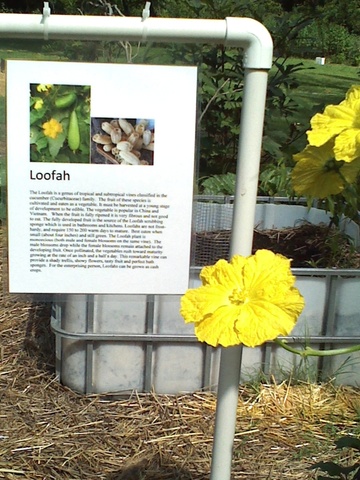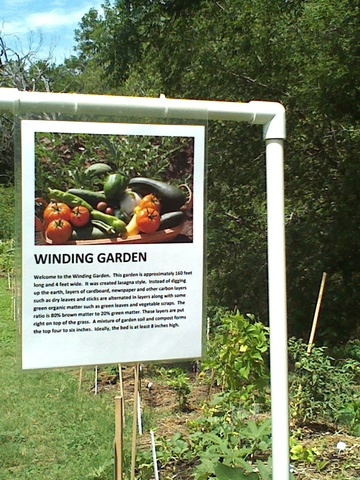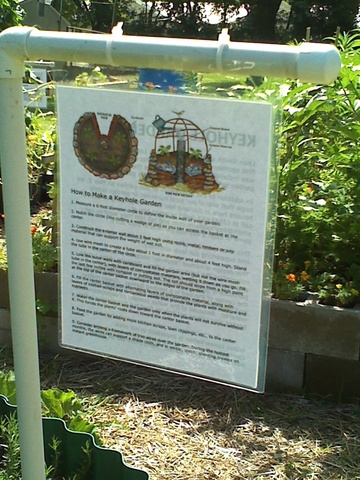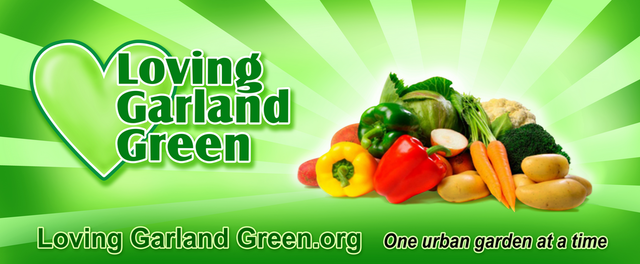
Becky and Ed Browning of Loving Garland Green installing their square foot garden at the Garland Community Garden -August 6, 2014
Square foot gardens were first introduced in 1982 by Mel Bartholomew. Unlike the traditional gardens which are planted in rows, these gardens are marked off into square feet. Each square foot is planted according to the size of the mature plant. For example, only one broccoli plant is allowed for a square foot. However, smaller plants such as onions, may be planted 16 plants to the square foot. Mr. Bartholomew recommends a special soil mix which consists of 1/3 vermiculite, 1/3 sphagnum moss and 1/3 garden soil/compost mixture. (We have a new sign down at the garden all about square foot gardens. A planting guide is illustrated on the back of the sign.)
___________________________________________________________________________
Gardens are like rivers. You can never step into the same one twice. So it goes with the Garland Community Garden at 4022 Naaman School Road.
In the last week we have added another square foot garden, a pumpkin patch and seven signs throughout the garden. In addition, we have planted numerous seeds and new plants--among them are three blackberry bushes. We hope to see you at the Garland Marketplace this Saturday, August 16. Loving Garland Green will have our own booth at this monthly community event.
In the coming weeks we hope to add a multicultural garden plot down at the garden which will be stocked with plants that immigrants to our community grow in their gardens as well as a plot that will be sponsored by senior citizens in our community. Here are a few photos and related stories regarding all our garden news:
_______________________________________________________________________

Sign Introducing Visitors to the Loofah
Frankly I'm surprised that we don't see more loofah vines growing in the DFW area.
The Loofah is a genus of tropical and subtropical vines classified in the cucumber (Cucurbitaceae) family. The fruit of these species is cultivated and eaten as a vegetable. It must be harvested at a young stage of development to be edible. The vegetable is popular in China and Vietnam. When the fruit is fully ripened it is very fibrous and not good to eat. The fully developed fruit is the source of the Loofah scrubbing sponge which is used in bathrooms and kitchens. Loofahs are not frost-hardy, and require 150 to 200 warm days to mature. Best eaten when small (about four inches) and still green. The Loofah plant is monoecious (both male and female blossoms on the same vine). The male blossoms drop while the female blossoms remain attached to the developing fruit. Once pollinated, the vegetables rush toward maturity growing at the rate of an inch and a half a day. This remarkable vine can provide a shady trellis, showy flowers, tasty fruit and perfect bath sponges. For the enterprising person, Loofahs can be grown as cash crops. (If you visit expensive bath product shops, take a look at their expensive loofah scrubbers. Fresh Connections is already taking advantage of the cash potential provided by loofahs. They sell small cross-sections of loofahs that are filled with handmade soap. Check out the Fresh Connections booth this Saturday at the Garland Marketplace and you'll see what I mean.)

Sign in the Winding Garden area of the Garland Community Garden
This garden is approximately 160 feet long and 4 feet wide. It was created lasagna style. Instead of digging up the earth, layers of cardboard, newspaper and other carbon layers such as dry leaves and sticks are alternated in layers along with some green organic matter such as green leaves and vegetable scraps. The ratio is 80% brown matter to 20% green matter. These layers are put right on top of the grass. A mixture of garden soil and compost forms the top four to six inches. Ideally, these beds are at least 8 inches high. Among a variety of vegetables, we have 14 tomato plants in this area--most of which are Sun Gold tomatoes. Sun Golds are a hearty, prolific, disease resistant variety. As for taste: they can't be beat. In fact, you could serve Sun Golds as dessert in some circles and get away with it. These plants bear the sweet fruit well into fall until the first frost and also make a great fall-planted crop in warm regions such as ours.
_______________________________________________________________________________________________

August 10, 2014 the pumpkin patch at the Garland Community Garden was born.
The pumpkin seeds were donated by Ken Risser of Keep Garland Beautiful. Ken, an intelligent high-energy guy, dropped by with the seeds and suggested that we needed a pumpkin patch. We agreed. The rest is history--except for growing our relationship with Ken and the folks from Keep Garland Beautiful.
Keep Garland Beautiful is a 501(c)(3) non-profit organization dedicated to create a clean, beautiful, litter-free Garland through education, public awareness and community involvement. Their community outreach programs help adult citizens and young people better understand why litter is a problem and how they can play an active role in litter prevention and removal and community beautification.
KGB is governed by a volunteer Board of Directors and is a division of the City of Garland Environmental Waste Services Department. KGB, an affiliate of Keep Texas Beautiful and Keep America Beautiful, is an award-winning state and national program.
Visit the garden often and watch the pumpkins grow. The patch is definitely an experiment in pushing Mother Nature’s envelope as it was planted August 10. This has been an awful year for squash bugs in Garland and thus we hesitated to plant a pumpkin patch at all. Since it takes 110 days for pumpkins to mature from planting, if these pumpkins survive the squash bugs (who like pumpkins too), they will be mature just in time for Thanksgiving pies. Come and visit often to monitor their progress, but please: don’t place any bets. It’s all a toss-up among the pumpkins, the squash bugs and the first frost. As for the rest of us, except for watering and occasional weeding, we are just spectators watching the race against time. Regardless, all will not be lost as we will put the vines into our compost for new soil next year.
______________________________________________________________________________

One of our new garden signs tells visitors how to build their own keyhole garden.
As far as we know, the Garland Community Garden currently has the distinction of being the only community garden on Garland City property and is the only community garden in Garland with a keyhole garden. Leon Smith of Clayton Texas donated this keyhole garden to us. You can read more about Leon and this garden design at the Garland Community Garden and at Loving Garland Green.org.
________________________________________________________________________________________
Our new banner will be featured at our Garland Marketplace booth this Saturday. We hope you will stop by. The design of this banner is a group effort involving Ken Dyer who designed the Loving Garland Green logo, Liz Berry who created the layout, Robert Opel who added the artistic sunburst background and corrected the dpi resolution, and Anita Opel who managed this project.
